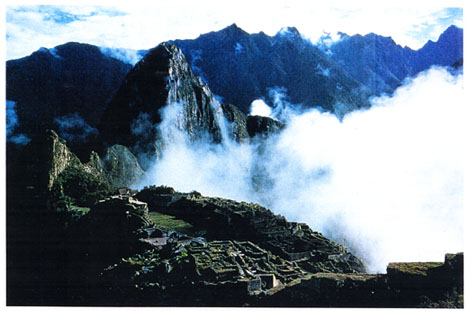

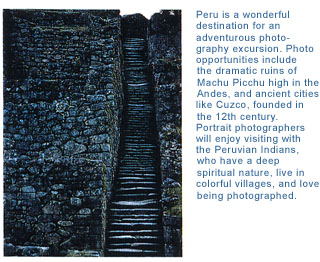
Watching the swirling fog uncover the most spectacular archeological site in the world. Basking in the unique sights, sounds and aromas of an exotic marketplace. Looking into the eyes of an 80-year-old Quechua Indian, and waiting for her true character to emerge. Experiencing moments like these, and capturing them on film, are the reasons I chose to be a travel documentary photographer.
I love telling stories of faraway places, and preserving them on film. I also thrive on the adventures and experiences that my journeys provide. From the minute I awake, until the moment I lay my head on my pillow at night, I am photographing subjects that reveal the true character of worlds that are far different from home.
My recent trip to Peru was one of my most exhilarating and meaningful adventures to date. Years ago, my grandfather’s old slides, and his National Geographic magazines depicting the magic of Machu Picchu, sparked my imagination. I always dreamed of visiting these magnificent ruins high in the Andes.
Architectural Capital of the Americas
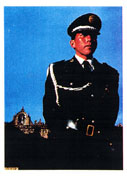

My trip began in Cuzco, the architectural capital of the Americas and the continent’s oldest continuously inhabited city.
Founded in the 12th century, and over 10,800 feet above sea level, it is steeped in history, legend and tradition. Any trip to the area should include visits to the museums and churches of Cuzco, The Plaza De Armas is located in the heart of the city, and is a great location to photograph people with beautiful old buildings as a backdrop.
After 10 days exploring Cuzco, I embarked upon a 10-day road and rail journey through remote rugged landscapes. I visited some very isolated mountain communities where the Quechua Indians reside. These hardworking Peruvians have a deep spiritual nature, love being photographedand, and live in colorful villages. I explored and photographed the ruins of Tipon, Pikillacta, and Pisac, before setting off on some exhilarating back roads through the Sacred Valley.

Technical Tips
When making environmental portraits, I try to photograph people at work or interacting with others; they are much less self-conscious and natural under these conditions. As I size up potential scenes, I search for faces with “character,” at the same time pondering photographic variables like lighting, color and composition.
Once I start shooting, I strive to keep my people photos as natural and realistic as possible.
I also prefer that my subjects take their own poses; I may guide them a bit, but I enjoy seeing what they come up with first. Then while talking to my subjects the entire time, I shoot quickly from a variety of positions, angles, and focal points.When traveling in exotic locales, I recommend hiring a driver who can also serve as a translator.
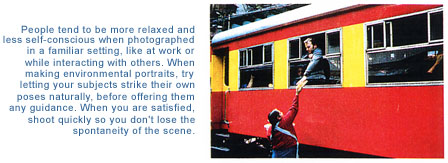


Such services are often surprisingly affordable, and enable you to concentrate on your next photograph while the driver negotiates the often rough and dangerous roads.
When shooting landscapes, it’s particularly important to travel slowly and concentrate on the more subtle elements in each image. First, attempt to determine your reason for taking the photograph, then figure out the best way to approach it. Typically, I scrutinize the surroundings very carefully, and then use my camera’s viewfinder to explore the elements which attract me the most.
On to Machu Picchu
After a week-long photo adventure in towns like Ollayantambo, Chinchero, Pocatambo and Moras, I was ready for the final leg of my journey. Hair-raising drives on high mountain roads, mystical shaman rituals, and frenzied election rallies kept my adrenaline flowing like the Rio Urubamba after the rainy season. A three-hour train ride took me to the lively and colorful town of Aguas Calientes, situated only 20 minutes from Machu Picchu.
For four days, Aguas Calientes provided the perfect home base for photographing this area. Endless subject matter makes the shooting come easy. Every morning before sunrise I took the first bus up to Machu Picchu, which I usually had to myself for the first couple of hours. Then I’d hike the Inca Trail for most of the day, returning to Machu Picchu late in the day to shoot under different lighting conditions.
A flexible itinerary is beneficial for trips like these, and provides the freedom to remain at a location as long as necessary to get the photographs you desire. Needless to say, I never had hotel reservations; when I arrived in a town I consulted my Lonely Planet Travel Guide and chose a hotel that seemed interesting.

Gear Tips
I typically shoot about 100 rolls of slide film on a two-to three-week trip, keeping all my equipment and film clean and dry inside Ziplock bags. I always travel with three camera bodies, so I have backups in case I experience any problems with my primary camera. Since I like to travel light, most of my shooting is done with a versatile, multi-purpose 28-200mm zoom lens.
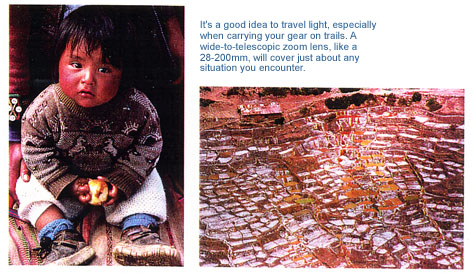
My camera is an extension of both my mind and my heart. Having used the same SLRs for over 20 years, I have now mastered their use. Therefore, I can let my mind run free with the constant visual stimulation I experience 12 hours a day.
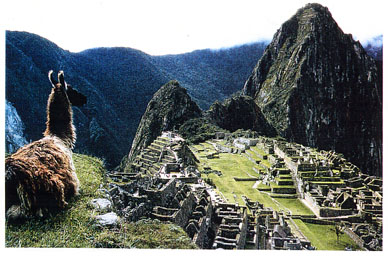
Editing is an important part of the creative process, and I’ve learned to be ruthless in this regard; 90 percent of my slides end up in the trash can. I often shoot 10-20 images of the same subject, and make it my goal to come up with one or two outstanding images.
I enjoy sharing my photographs with as many people as possible, so that others can learn what these faraway places are really about. Slide shows and lectures are a satisfying way to do this, because they provide you with a direct and immediate response from a live audience.
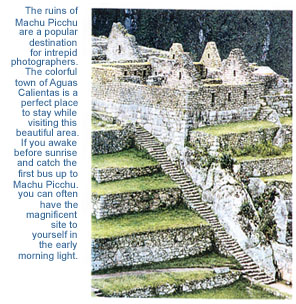
My Connecticut television show, “The Unconventional Traveler,” also enables me to share my works with large numbers of people. And having my work published in national magazines is not only rewarding, but gives the work permanence. Being a travel documentary photographer fulfills my two great passions in life – travel and photography. Peru proved to be a photographer’s paradise in many ways, with wonderful, colorful, friendly people who have fascinating lifestyles. Awe-inspiring ruins and mysterious landscapes with magical light will fill your days with enlightenment and beauty.
After 30 years of dreaming about this faraway land, I finally fulfilled my quest in several ways. By traveling slowly by myself, I had the freedom to experience Peru completely on my own terms. Not knowing what each new day would bring, I found the photography always exciting and the new adventures numerous. And now my images will live on for present and future generations to see how this most special country appeared at the turn of the millennium.
